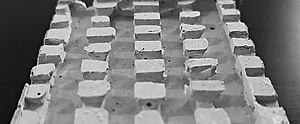ReCon. Development of a resilient hook-and-loop fastening system for the adaptable asssembly of building components in building construction.
Climate neutrality in the building sector, a sector that is globally responsible for about 36% of final energy consumption and about 39% of energyrelated CO2 emissions [1], as well as for about 40% of resource consumption [2] (in Austria about 60% [3]), requires a holistic approach. Accordingly, life cycle assessments as well as environmental product declarations evaluate buildings and building components on the basis of all building phases [4, 5] and the Austrian Climate and Energy Strategy calls for resilience as the ability to adapt to different requirements in the short and long term. Climate-neutral as well as circular buildings thus require an appropriate design of the constructive interfaces between building components of different function and use, between short-lived and long-lived as well as materially heterogeneous building components. What is required is flexibility, as a result of an easily separable composite, ease of maintenance, accessibility and standardisation, [6] in both new construction and refurbishment. The exploratory „Klett-TGA“ (FFG PN.: 861664) and the “hook-and-loop façade” development with Sto Ges.m.b.H and Gottlieb Binder GmbH & Co. KG „StoSystain R“ show, that the hook-and-loop fastening technology can meet these requirements better than conventional methods.
For these reasons, the aim is to establish the hook-and-loop fastening system as a resilient and intelligent connection system in the construction industry, between the primary structure and the secondary structure and, subsequently, the tertiary structure. The project objective is therefore to verify the applicability of the hook-and-loop fastening system between primary, secondary and tertiary structures depending on the application case and the components used. For this purpose, concepts are developed and tested and verified on a theoretical level as well as in the laboratory/company. With the aim of increasing ecology, the production of hook-and-loop components from concrete, wood and paper materials is also being investigated in basic experiments (reduction of material consumption; replacement of petroleum-based materials with renewable bio-based materials).
The object of investigation is thus formed by („hookable“) shell components (concrete and wood) and the counterpart in the form of a „hook-and-loop“ assembly means with regard to the requirements in construction, (further), industrial hook-and-loop components. In addition, with regard to a circular economy, sensor technologies for component data management are integrated into the research project in view of digitalisation and in the form of material pass ports [7] as well as e.g. digital watermarks[8].
Project duration:
November 2022 – April 2025
Funding:
The Austrian Research Promotion Agency (FFG)
Project team:
Institute of Architecture Technology: Roger Riewe, Matthias Raudaschl, Clemens Berlach, Toni Levak, Ernst Alexander Dengg, Selina Haingartner, Semjon Popek
Project and Cooperation partners:
Laboratory for Structural Engineering: Bernhard Freytag, David Danner
Institute of Bioproducts and Paper Technology: Ulrich Hirn, Thomas Harter, Cemile Sözeri
Axtesys GmbH: Markus Moser, Angelika Weber, Leonie Haas, Peter Treitler, Simon Klima
NET-Automation GmbH: Walter Rieger, Gernot Theuermann, Christian Zuber
[1] IEA and UNEP: 2018 Global Status Report, 11
[2] IRP: Assessing global resource use, 2017, 64
[3] BM für Land- und Forstwirtschaft, Umwelt und Wasserwirtschaft; Wissenschaft, Forschung und Wirtschaft (Hrsg.): Ressourcennutzung in Österreich, 2015, 35
[4] EN ISO 14044:2006, Umweltmanagement. Ökobilanz. Anforderungen und Anleitungen, 2006
[5] ÖNORM EN 15804, Nachhaltigkeit von Bauwerken. Umweltproduktdeklarationen, 2020
[6] Bahr, C./Lennerts, K.: Lebens- und Nutzungsdauer von Bauteilen, 2010, 28-40
[7] Heinrich, M./Lang. W.: Materials Passports – Best Practice (BAMB), 2019
[8] AIM – European Brands Association: Digital Watermarks/Initiative HolyGrail 2.0, Brüssel, 2021

